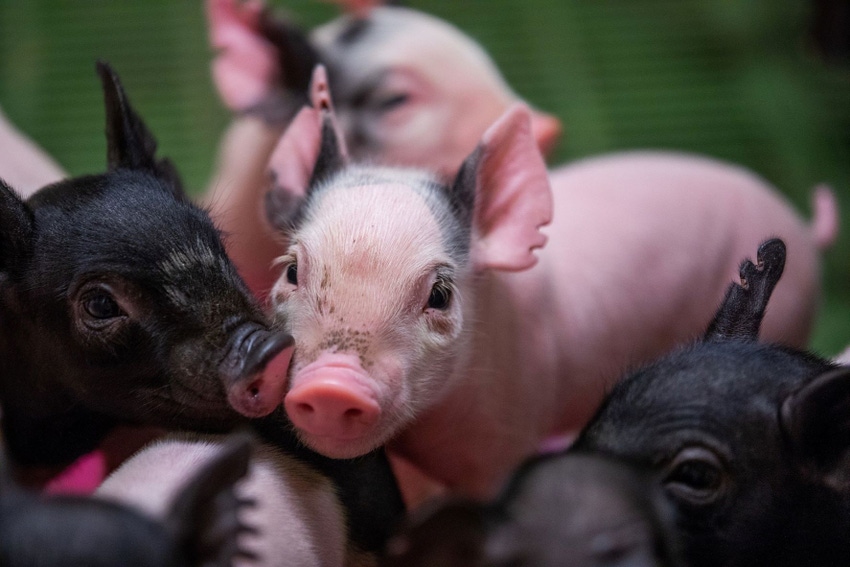ISU led study to analyze blood cell data to improve swine health
For first phase of grant, blood samples will be collected from young pigs under variety of healthy, infected conditions that mimic conditions found on farms.
October 18, 2022

Iowa State University scientists are leading a new study to mine the intricate content of pigs' blood cells to improve selection for disease resilience.
"We're looking for new, more effective ways to measure and predict different traits in pigs, especially disease resilience," says Christopher Tuggle, professor of animal science and the lead investigator on a new grant from the USDA National Institute of Food and Agriculture.
"Many of the traits pork producers want to improve by genetic selection are difficult to measure and predict," Tuggle says. "Growth rate is easy to measure, and as a result, we've made significant improvements in this area. Disease resilience, on the other hand, is much more challenging and an area where we haven't made enough progress."
Blood samples are often used as a practical way to search for markers of disease or immunity.
"Blood is easily collected and can tell a lot, but blood is a very complex mixture of cells doing lots of things," he says. "To make blood useful as a test for disease resistance, we need to better understand the composition of the cells and their numbers, as well as learn what they are actually doing."
For example, Tuggle explains, a neutrophil is a frontline soldier in the immune system that attacks invading disease threats immediately. It has a different expression pattern of its genes than lymphocytes, like B cells, which make antibodies that enhance disease resistance over time.
"One of our primary purposes is to very accurately measure the nature of all these different types of cells under different conditions," he says. "This will improve our ability to link the phenotypes of blood cells (traits we can measure) with an animal's health status, such as what is a B cell doing and how is it changing when an animal is healthy versus when it is sick?"
Jack Dekkers, a quantitative geneticist and distinguished professor of animal science at Iowa State, is a co-investigator on the $650,000 NIFA grant. Other collaborators are Crystal Loving, a specialist in swine immunology at the USDA-Agricultural Research Service National Animal Disease Center in Ames, and Joan Lunney, a swine immunologist and geneticist at the USDA-ARS Animal Parasitic Diseases Laboratory in Beltsville, Maryland. Luke Kramer, a post-doctoral fellow and computational scientist in animal science at Iowa State, will also assist and mentor two graduate students involved with the study.
For the first phase of the grant, primarily managed by Loving, blood samples will be collected from young pigs under a variety of healthy and infected conditions that mimic conditions found on farms. Tuggle and Loving will work together to analyze all cell types across these samples. One of the team's tools for its blood detective work is single-cell analysis, a new technique that can measure the expression of genes in each individual cell in a sample, rather than taking an average of cells.
"This gives us the vision to look more precisely at all the cell types in a complex sample to untangle the knots," Tuggle says.
"The basic immunological data connected to these blood samples will be made publicly available. This could have a very broad impact on improving understanding of the swine immune system, and on improving animal genetic selection," Loving says.
Once the molecular nature of all the cell types is known, Tuggle and Dekkers will apply that information to improve the use of blood data to predict the most resilient pigs. This step will use data from over 1,800 pigs that have been followed from weaning (about five weeks of age) to market, provided by a project funded through the PigGen Canada research consortium directed in the United States by Dekkers.
In the final phase, Tuggle will collaborate with Lunney to create a practical method to quickly measure such predictive patterns in industry populations, providing a new tool to improve pig health.
The new grant grew out of the Functional Annotation of the Animal Genome project, and the work will continue to inform this partnership and other related efforts.
Source: Iowa State University College of Agriculture and Life Sciences, which is solely responsible for the information provided, and wholly owns the information. Informa Business Media and all its subsidiaries are not responsible for any of the content contained in this information asset.
You May Also Like



